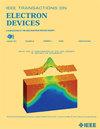Backside Contact Misalignment-Induced TDDB in BSPDN CFET
IF 3.2
2区 工程技术
Q2 ENGINEERING, ELECTRICAL & ELECTRONIC
引用次数: 0
Abstract
Complementary field-effect transistors (CFETs) and backside contacts (BSCs) are the effective approaches for reducing cell layout size. However, since BSC is formed post wafer bonding and extreme wafer thinning, bonding-induced wafer distortion inevitably introduces BSC alignment challenges, with control of its misalignment toward the layers on the wafer’s frontside requiring careful attention. As misalignment increases, the distance between the BSC and the gate decreases, resulting in a strong electric field concentration in the bottom oxide of the CFET. In this study, metal–insulator–metal (MIM) capacitors with gate-to-BSC overlap caused by misalignment were fabricated and used to calibrate a time-dependent dielectric breakdown (TDDB) simulation. Additionally, using 3-D technology computer-aided design (TCAD), we extracted the electric field applied to the bottom oxide as a function of misalignment, based on both experimental data and the calibrated CFET model. By inputting the extracted electric field into the TDDB simulator, we evaluated the degradation of oxide lifetime. The results show that using Mo metal for the BSC significantly reduces the electric field compared to W metal, thereby leading to an overall increase in TDDB lifetime. These findings provide valuable insights into the impact of BSC misalignment on CFET reliability and highlight the importance of material selection and precise alignment control for process optimization.BSPDN CFET中背接触不对中诱发的TDDB
互补场效应晶体管(cfet)和背面触点(BSCs)是减小电池布局尺寸的有效方法。然而,由于BSC是在晶圆键合和晶圆极度变薄后形成的,因此键合引起的晶圆畸变不可避免地会带来BSC对准方面的挑战,需要仔细注意控制其朝向晶圆正面层的不对准。随着不对准的增加,BSC与栅极之间的距离减小,导致cfeet底部氧化物中的强电场集中。在这项研究中,制造了由于不对准导致栅极与bsc重叠的金属-绝缘体-金属(MIM)电容器,并用于校准时间相关介电击穿(TDDB)模拟。此外,利用三维计算机辅助设计(TCAD)技术,基于实验数据和校准的CFET模型,我们提取了施加在底部氧化物上的电场作为不对准的函数。通过将提取的电场输入到TDDB模拟器中,我们评估了氧化物寿命的退化。结果表明,与W金属相比,使用Mo金属作为BSC显著降低了电场,从而导致TDDB寿命的整体增加。这些发现为平衡计分卡偏差对CFET可靠性的影响提供了有价值的见解,并强调了材料选择和精确对准控制对工艺优化的重要性。
本文章由计算机程序翻译,如有差异,请以英文原文为准。
求助全文
约1分钟内获得全文
求助全文
来源期刊

IEEE Transactions on Electron Devices
工程技术-工程:电子与电气
CiteScore
5.80
自引率
16.10%
发文量
937
审稿时长
3.8 months
期刊介绍:
IEEE Transactions on Electron Devices publishes original and significant contributions relating to the theory, modeling, design, performance and reliability of electron and ion integrated circuit devices and interconnects, involving insulators, metals, organic materials, micro-plasmas, semiconductors, quantum-effect structures, vacuum devices, and emerging materials with applications in bioelectronics, biomedical electronics, computation, communications, displays, microelectromechanics, imaging, micro-actuators, nanoelectronics, optoelectronics, photovoltaics, power ICs and micro-sensors. Tutorial and review papers on these subjects are also published and occasional special issues appear to present a collection of papers which treat particular areas in more depth and breadth.
 求助内容:
求助内容: 应助结果提醒方式:
应助结果提醒方式:


